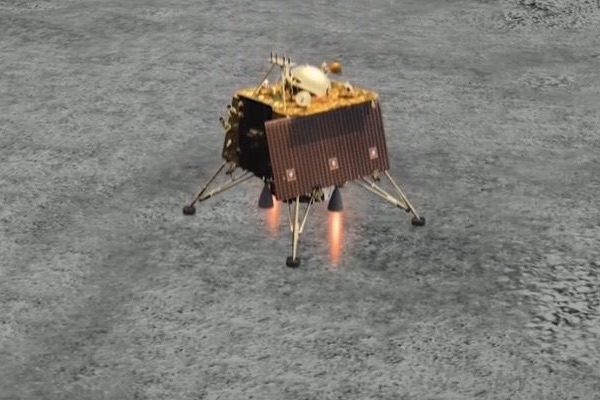Learning from Chandrayaan 2 for Indiaby Ajay P. Kothari
|
| One cannot improve if one does not face the mistakes head on, look them in the eye and defeat them the next time. |
It was indeed heartbreaking to not be able to obtain analysis of the water ice near the south pole, which would have been forthcoming had the Vikram lander been successful in soft landing. It would have helped all potential planners of lunar exploration and aided further space exploration of solar system immensely if the lander turned up ground truth about the ice thought to be there from orbital data. We hope any further steps will be helped by the suggestion below, which may still only be a conjecture.
The saga of Chandrayaan 2’s lunar journey
Chandrayaan 2 took a long time getting to the Moon: almost a month and a half, unlike Chang’e 5, which arrived within a week. The spacecraft used six Hohmann transfers to get to the lunar neighborhood. The analysis presented below was done using perigee altitudes from published news accounts from India and other astrodynamics textbook formulations and equations. By contrast, China performed only one translunar injection maneuver and hence a single near Hohmann transfer, not counting the two trajectory correction maneuvers.
| Orbit | Perigee (km) | Apogee (km) | Orbit raised |
|---|---|---|---|
| Ellipse 0 | 169.7 | 45475 | 22-Jul |
| Ellipse 1 | 230 | 45163 | 24-Jul |
| Ellipse 2 | 251 | 54829 | 25-Jul |
| Ellipse 3 | 276 | 71792 | 29-Jul |
| Ellipse 4 | 277 | 89472 | 2-Aug |
| Ellipse 5 | 276 | 142975 | 6-Aug |
| Ellipse 6 | 276 | 600000 | 14-Aug |
After being captured by the Moon’s gravity, it performed an additional six Hohmann transfers. Again these are computed and shown below.
| Orbit | Periluna (km) | Apoluna (km) | Orbit Decreased |
|---|---|---|---|
| Orbit 1 | 114 | 18072 | 20-Aug |
| Orbit 2 | 118 | 4412 | 21-Aug |
| Orbit 3 | 179 | 1412 | 28-Aug |
| Orbit 4 | 124 | 164 | 30-Aug |
| Orbit 5 | 119 | 127 | 1-Sep |
| Orbit 5 | 119 | 127 | 2-Sep |
| Orbit 5 | 104 | 128 | 3-Sep |
| Orbit 6 | 35 | 97 | 4-Sep |
| Landing attempt | 35 | 97 | 7-Sep |
The orbiter’s continuing mission
It appears that the liquid hydrogen/liquid oxygen engine on the third stage of Chandrayaan 2’s rocket fired for longer than expected. This put Chandrayaan 2 into a faster perigee orbit to begin with. This saved some fuel in the orbiter at the end of all orbit raising (Earthbound) and de-orbiting (Moonbound) maneuvers. This is why the orbiter will be able to remain in orbit for perhaps seven years instead of just one or two.
The orbiter has an L-band and S-band SAR (Synthetic Aperture Radar) for penetrating up to five meters below the surface. This is enough to map both poles for water ice. The Orbiter High Resolution Camera (OHRC) produces imagery with a resolution of 0.32 meters from its 100-kilometer orbit. If additional de-orbiting is performed to bring the craft to 50 kilometers or closer, the seven-year orbital lifetime will decrease but it will produce better data.
Vikram: what may have gone wrong
The “Rough Braking” period, possibly employing all four side engines plus one central engine of 800 newtons thrust each, most likely at full or near full thrust, was successfully accomplished.
| Throttling equally all four side engines simultaneously after one and a half months of hibernation would be risky. |
During the “Fine Braking” period, there was a small anomaly around an altitude of five kilometers when there was too large a horizontal velocity, which seems to have been successfully corrected quickly.
However, between four and three kilometers from the lunar surface, the same anomaly reappears, again it tries to correct for it by rotating the spacecraft counter-clockwise.
What may have gone wrong? This was possibly done by differential thrust from the four side engines while throttling. There does not seem to be any other explanation. One or more of the throttling valves may have malfunctioned, creating an imbalance in thrust that may have resulted in a partial somersault and also generated downward, thrust increasing rather than decreasing the vertical velocity while also decreasing the horizontal one. This made the lander crash at high speed and also about half a kilometer short of the target landing spot.
Throttling equally all four side engines simultaneously after one and a half months of hibernation would be risky. All throttle valves have to open and close exactly the same amount at least in all four side engines at all times during the Fine Braking phase. This would be risky even without hibernation. Chang’e-5 employed only one engine (and hence one rocket nozzle) for landing. So does Falcon 9 when its first stage lands.
In the next go-around, India should try using only one engine in the center for landing. This does not remove the possibility of something going wrong, but it ameliorates it. Theoretically another way to partially ameliorate this at least is to allow for a smaller time interval from takeoff to the Moon, which may not be possible with the GSLV MkIII rocket used for this mission. But it may give a Vikram 2 a better chance of success for Chandrayaan 3 mission.
Note: we are temporarily moderating all comments submitted to deal with a surge in spam.
